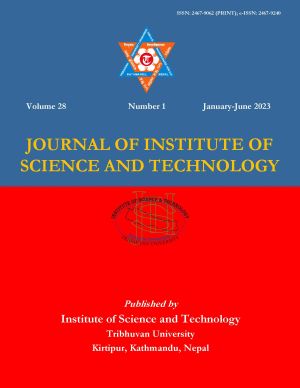Influence of Southern Oscillation Index on Rainfall Variability in Nepal during Large Deficient Monsoon Years
DOI:
https://doi.org/10.3126/jist.v28i1.43452Keywords:
Anomalies, deficit monsoon years, El Niño, Nepal, southern oscillation indexAbstract
The study was conducted using rainfall time-series data for 42 years from 1977 to 2018. We have identified seven large monsoon deficient years. Among these years, 1992, 2009, and 2015 consisted of El Niño episodes which quantify significant rainfall deficits 19.29, 13.6, and 17.59 % respectively from an average rainfall. With some exceptions, all El Niño years observed deficit rainfall. On El Niño years averaged deficit rainfall was approximately nine percent below than the average monsoon rainfall. The eastern region observed the large deficient monsoon years frequently than the central and western regions of Nepal. The central region recorded large spatial variability of average summer rainfall ranging from less than 200 mm/months in lesser Himalayans to more than 3,000 mm/months in mid-mountainous region. The western region had observed a large deficient summer monsoon anomaly 45 % in the year 1979. Similarly, the central region had 31 % deficient summer monsoon anomalies in 1992, and the eastern region observed 25 % deficient anomalies in 1982. There was a strong correlation between the Nepal Summer Monsoon Rainfall (NSMR) and Southern Oscillation Index (SOI). Generally, large negative/positive magnitude of SOI on the Indian and Pacific Ocean has link to weakening/strengthening NSMR.
Downloads
Downloads
Published
How to Cite
Issue
Section
License
Copyright (c) 2023 Institute of Science and Technology, T.U.

This work is licensed under a Creative Commons Attribution-ShareAlike 4.0 International License.
The views and interpretations in this journal are those of the author(s). They are not attributable to the Institute of Science and Technology, T.U. and do not imply the expression of any opinion concerning the legal status of any country, territory, city, area of its authorities, or concerning the delimitation of its frontiers of boundaries.
The copyright of the articles is held by the Institute of Science and Technology, T.U.




